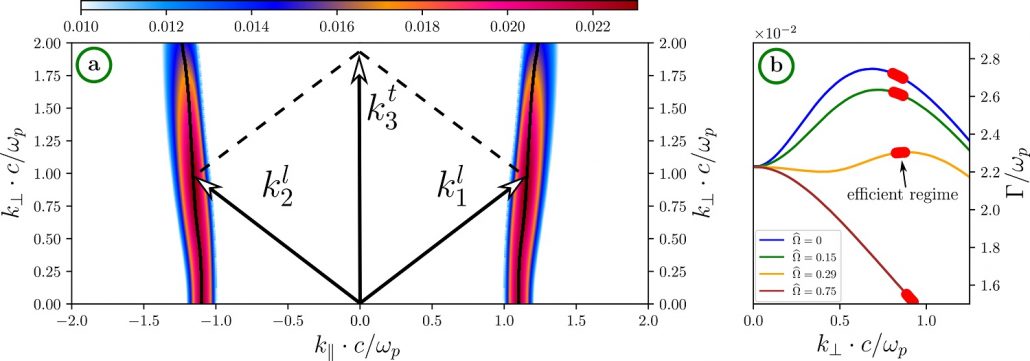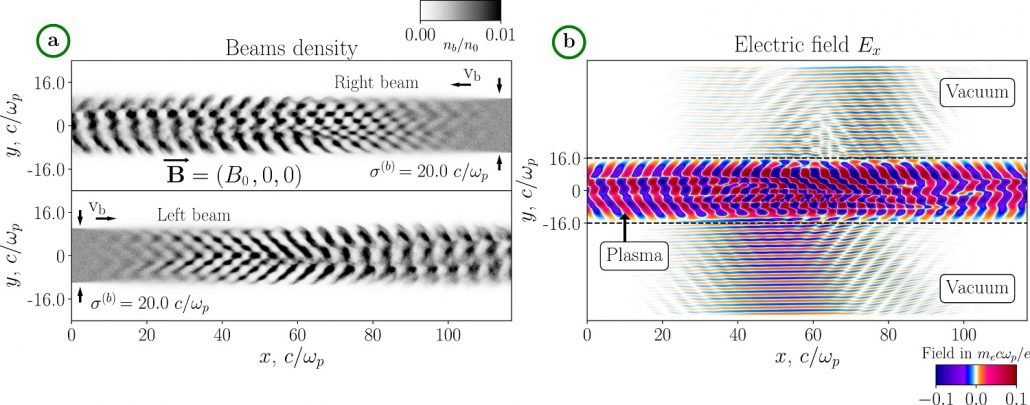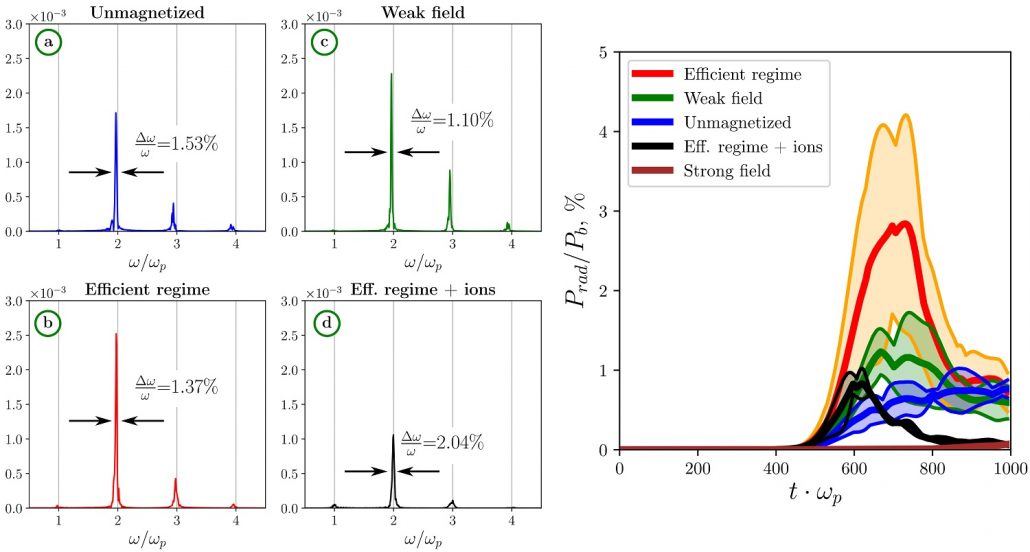Weakly turbulent processes of three-wave interactions between Langmuir and electromagnetic waves in plasma with unstable electron flows are believed to be the main cause of type II and III solar radio emissions. The narrow band of type II bursts requires assuming that this radiation is generated in some local regions of shock fronts traveling in the solar corona, where the specific conditions for the enhancement of electromagnetic emissions near the plasma frequency harmonics are created. The reason for such enhancement at the second harmonic may be the formation of counterstreaming electron beams Ganse et al. [1]. Indeed, in the case of a single beam, before generating EM radiation in three-wave interactions, the vast majority of the beam energy is wasted on the excitation of a wide spectrum of nonradiating electrostatic oscillations through the electrostatic decay of primary unstable Langmuir waves and consequent plasma heating. The energy sink from the resonant to nonresonant part of the wave spectrum can be, in principle, reduced if both electrostatic waves participating in the three-wave process are excited directly by two counterstreaming electron beams. However, Ziebell et al. [2] have studied the generation of EM waves by counterstreaming beams by solving equations of weak turbulence and found that its enhancement is not that pronounced compared to the single-beam case as reported by Ganse et al. [1]. In our work, we show that there are two reasons why the efficiency of the second harmonic emission from a plasma with counterstreaming electron beams should be higher than in previous works. The first reason is the fundamentally nonuniform character of beam–plasma interaction, which is not accounted for in models with periodic boundary conditions assuming that the beam is uniformly distributed in the whole space. In the case of continuous beam inflow from local acceleration sites, instead of excitation of low-amplitude waves with stochastic phases, we observe the formation of coherent wave packets with higher densities of Langmuir wave energy. This affects not only EM emission, but also ion dynamics, which can no longer be described in terms of sound waves and is more governed by ponderomotive forces of high-frequency fields even for relatively small beam densities $10^{-3}$. The second reason is the possibility of tuning the system parameters in such a way that the most unstable (and most energetic) colliding beam-driven modes begin to participate in the nonlinear coalescence process.
We carried out particle-in-cell simulations of the collision of two symmetric electron beams in plasma with open boundary conditions [3] and show that the efficiency of beam-to-radiation power conversion can be significantly increased up to the level of a few percent if three-wave interactions with electromagnetic waves near the second harmonic of the plasma frequency becomes available for the most unstable, oblique, beam-driven modes. To prove the feasibility of this efficient regime, we first find the system parameters at which the maximum linear growth rate (Fig. 1a) calculated in the framework of the relativistic kinetic theory [4] lies in the region of three-wave interaction and then compare this regime with less efficient ones in which the most unstable modes drop out of this resonance (Fig.1b).

Figure 1: (a) The growth rate map for the beam-plasma instability $\Gamma\left(k_\parallel,k_\perp\right)$ in the efficient regime. The black line $k_\perp=k_\perp(k_\parallel)$ marks the maximal growth rate achieved for each $k_\perp$. The arrows $k^l_1$ and $k^l_2$ correspond to the wave vectors of the most unstable beam-plasma modes. The wave vector of radiated EM wave $k^t_3$ is the result of their summation.(b) $\Gamma(k_\perp)$ along the line of the local maximum (red points indicates the region of the three-wave interaction) for all considered regimes with different magnetic fields characterized by the dimensionless electron cyclotron frequency $\widehat{\Omega}=\Omega_e/\omega_p$. Adapted from: Annenkov et al. [5]
PIC simulations of beams collision confirmed the dominance of oblique modes in the efficient regime and demonstrated the formation of spatially localized relaxation regions. EM emission near $2\omega_p$ is observed when such regions of both beams intersect with each other (Fig. 2). At later stages of the interaction, we also observe generation of higher harmonics at $3\omega_p$ and $4\omega_p $ (Figure 3a-3d). For each case, we carry out several (from three to five) runs with identical initial macro-parameters, but with a different specific implementation of the particle distribution function.

Figure 2: PIC results in a time moment of emission maximum for the efficient regime. (a) Density of both beams in units of unperturbed plasma density $n_0$. (b) Electric field $E_x$. Langmuir waves in plasma column and $2\omega_p$ emission in vacuum.

Figure 3: (a)-(d) The frequency spectrum of the produced radiation in the single point in vacuum. (c) The efficiency of beam-to-radiation power conversion as a function of time for all runs. The methodology for constructing these dependencies is as follows. In each moment of time, from all the runs corresponding to one regime, the highest and lowest radiation efficiencies are found and placed on the graph. The thick line indicates the average value between them. Adapted from: Annenkov et al. [5]
Figure 3 (e) shows the beam-to-radiation power conversion efficiency. Despite the significant scatter of results for the efficient regime, the typical value of the generation efficiency is several percent while the maximum efficiency reaches 4%. When switching to regimes with lower magnetic fields, the efficiency decreases several times. In the case of a strong field the beam instability becomes purely longitudinal and there is no noticeable radiation.
Based on the recently published paper: V. V. Annenkov, E. P. Volchok, and I. V. Timofeev. Electromagnetic emission produced by three-wave interactions in a plasma with continuously injected counterstreaming electron beams. The Astrophysical Journal, 904 (2):88, nov 2020. doi: 10.3847/1538-4357/abbef2.
References:
[1] Urs Ganse, Patrick Kilian, Felix Spanier, and Rami Vainio. Nonlinear wave interactions as emission process of type II radio bursts. The Astrophysical Journal, (2):145, jun . ISSN 15384357. doi: 10.1088/0004-637X/751/2/145.
[2] L. F. Ziebell, L. T. Petruzzellis, P. H. Yoon, R. Gaelzer, and J. Pavan. Plasma emission by counter-streaming electron beams. The Astrophysical Journal, 818(1):61, feb 2016. ISSN 1538-4357. doi: 10.3847/0004-637X/818/1/61.
[3] V. V. Annenkov, E. A. Berendeev, I. V. Timofeev, and E. P. Volchok. High-power terahertz emission from a plasma penetrated by counterstreaming different-size electron beams. Physics of Plasmas, (11):113110, nov . ISSN 1070-664X. doi: 10.1063/1.5048245.
[4] I. V. Timofeev and V. V. Annenkov. Exact kinetic theory for the instability of an electron beam in a hot magnetized plasma. Physics of Plasmas, 20(9): 092123, sep 2013. ISSN 1070664X. doi: 10.1063/1.4823722.
